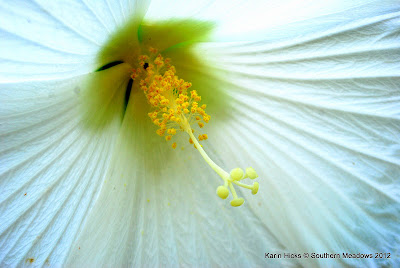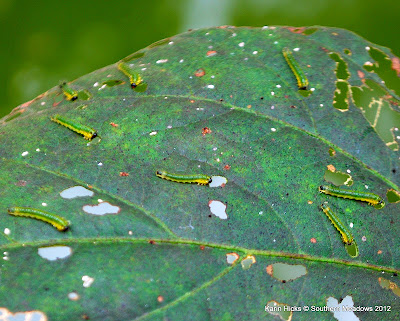Hibiscus are under attack!
Yikes, My beautiful hardy hibiscus are under attack!
The beautiful dinner plate size blooms are no more and the leaves are being eaten down to the veins.
The beautiful dinner plate size blooms are no more and the leaves are being eaten down to the veins.
This looks like damage from an insect with chewing mouth parts, but which one?
Upon closer inspection, there are loads of caterpillars happily eating away at the Blue River and Swamp Hibiscus. Hmmm...I wasn't aware that the hibiscus was a host plant for any butterfly or moth larva. Since this is my first time growing hibiscus I'd better figure this out. So off to my resource books I go to research...
Well, it turns out that these caterpillars won't turn into butterflies or moths. These caterpillar-like larvae are from the hibiscus sawfly, a plant feeding wasp. And I am hosting a party for hundreds! They feed on hibiscus, rose of sharon, hollyhock and mallow. My book Garden Insects of North America (The Ultimate Guide to Backyard Bugs) by Whitney Cranshaw (by the way, this is a very comprehensive book with lots of photos) says that these larvae can defoliate a plant in a very short period of time. No kidding! Look at my poor hibiscus, it certainly isn't the life of the party anymore!
Hand picking all these caterpillars off the leaves is a daunting task but if I am to save the plant the tedious work must begin quickly otherwise this plant will be at even more risk. After hand picking I sprayed the leaves with a soapy mixture to kill any larvae that I missed. The book tell me that sawflies can produce up to six generations in one season (May-October) so the infected plant will need to be sprayed multiple times.
Are these their egg sacks? This must be removed immediately!
There is a little new growth so I am hopefully that this plant will survive.
Has anyone else experienced an infestation of sawflies? What did you do and what where your results?






.png)
